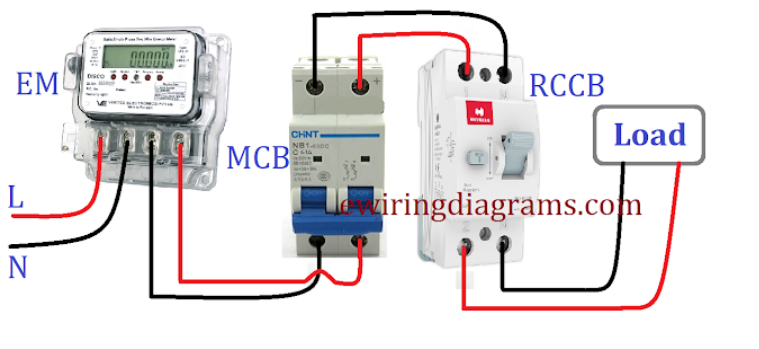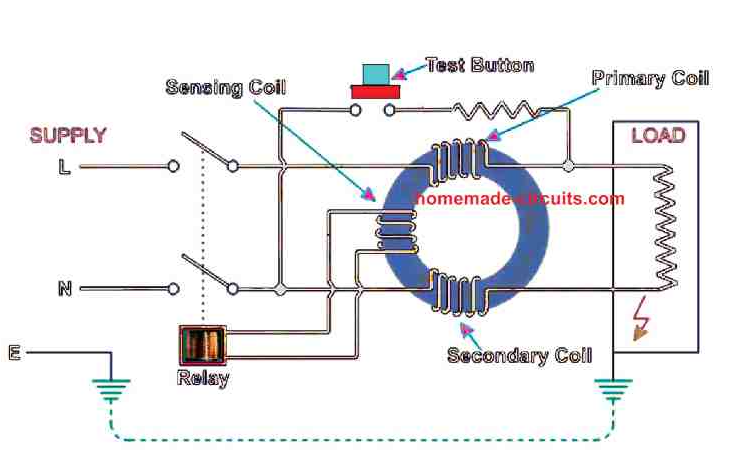7월 19, 2023
9424
Introduction
Ensuring the functioning of an RCCB is important for electrical safety. If an RCCB fails to trip when necessary, it poses significant risks. This article is dedicated to identifying common problems related to RCCB tripping, delving into their root causes, and providing effective solutions. In essence, the article will comprehensively address the reasons behind RCCB tripping issues and offer step-by-step guidance to rectify situations when the device does not perform as intended.
Catalog
What Can Cause an RCCB to Trip
RCCB stands for Residual Current Circuit Breaker. It is an essential electrical safety device designed to protect against electric shocks and fire hazards caused by ground faults or leakage currents.
RCCB utilizes the residual current sensing method based on Kirchhoff's current law to detect ground faults in the circuit and prevent potential accidents by rapidly shutting off the main circuit. Its importance and wide application in electrical systems make it an indispensable electrical protection device in modern buildings and industries.

An RCCB (Residual Current Circuit Breaker) works based on the principle of detecting and responding to residual currents or ground faults in an electrical circuit. Its main function is to ensure electrical safety by quickly disconnecting the power supply when such faults are detected.
Sensing Residual Current: The RCCB constantly monitors the current flowing in the live (phase) and neutral wires of an electrical circuit.
Differential Current Detection: The RCCB measures the difference in current between the live and neutral wires, known as the residual current. If the detected residual current exceeds a preset threshold, typically 30 milliamps (mA) or higher, the RCCB will initiate its tripping mechanism.
Tripping Mechanism: Upon detecting a residual current above the threshold, the RCCB quickly activates its internal electromagnetic tripping coil. This coil generates a magnetic field proportional to the residual current. If the current exceeds the predetermined threshold, the magnetic field becomes strong enough to attract the tripping mechanism, causing the RCCB to trip or disconnect the electrical supply to the circuit.
Rapid Disconnection: The tripping action of the RCCB is swift, occurring within milliseconds of detecting the fault. This rapid disconnection of the power supply protects individuals from electric shock.
Protection Against Fire Hazards: By disconnecting the power supply upon detecting ground faults or leakage currents, they help avert overheating and potential fire hazards.
Resetting the RCCB: After a tripping event, the RCCB needs to be manually reset to restore the electrical supply.

When an RCCB repeatedly trips, one of the common causes is a faulty appliance or device connected to the circuit.
Signs of malfunctioning appliances:
1. An RCCB consistently trips whenever a particular appliance is connected to the circuit
2. Unusual sounds or burning odors emanating from an appliance
3. Appliances that behave erratically, such as fluctuating power output or sudden shutdowns
4. Visible damage, frayed wires, or burnt components on the device
5. Appliances that become excessively hot during operation
Steps to Check and Isolate Problematic Appliances:
1. Unplug all devices and appliances connected to the circuit protected by the RCCB.
2. Reset the RCCB to restore power to the circuit.
3. Reconnect each appliance one by one to the circuit and observe the RCCB's behavior. If the RCCB trips immediately after connecting a specific appliance, it is likely the cause of the fault.
4. Carefully inspect the suspected appliance for any visible damage or anomalies. If possible, conduct a separate electrical test to confirm the presence of internal faults.
5. Repair or Replace Faulty Appliances
6. After addressing the faulty appliance, reconnect all other appliances and devices. Ensure that the RCCB no longer trips and that the circuit operates smoothly.
Ground faults occur when an unintended electrical connection is established between an energized conductor and a conductive surface, such as the earth or a metal casing. These faults can lead to leakage currents, where electricity flows to the ground instead of completing its intended circuit path.
When a ground fault occurs, there is an imbalance in the current flowing through the live and neutral wires. The RCCB promptly detects this residual current and quickly trips, disconnecting the power supply to the circuit. This immediate response is critical in preventing electric shock and mitigating potential fire hazards.
Tips to Locate and Resolve Ground Faults:
1. Look for charred marks, frayed wires, or loose connections, as these can indicate potential ground faults.
2. Using a digital multimeter, perform an insulation resistance test to check for any insulation breakdown in electrical circuits and equipment.
3. An earth leakage clamp meter can measure and analyze leakage currents in electrical systems.
4. Use a circuit tracer or tone generator to follow the path of electrical circuits and identify any deviations or potential ground faults.
5. Megger testing, also known as insulation resistance testing, can determine the insulation integrity of electrical wiring and equipment.
6. Infrared thermography can be used to detect abnormal heating in electrical components, indicating ground faults or overloaded circuits.
7. Disconnect portions of the electrical circuit one by one to isolate the area with the ground fault.
Water intrusion and moisture exposure in electrical circuits can lead to ground faults and leakage currents, which may trigger RCCB tripping. Water is a good conductor of electricity, and when it comes into contact with live electrical components or wiring, it can create unintended pathways for current flow to the ground.
Common scenarios where water exposure can cause RCCB tripping:
1. Wet Environments
2. Condensation
3. Leaky Roofs or Plumbing
Tips for Preventing Moisture-Related Tripping Incidents:
1. Install electrical components, switches, and sockets in waterproof and weather-resistant enclosures.
2. Seal cable entry points and junction boxes with appropriate grommets, cable glands, or waterproof seals.
3. Place electrical outlets and switches above the likely water level in wet areas like bathrooms.
4. Regular Maintenance
5. Install Ground Fault Circuit Interrupter (GFCI) outlets
6. Ensure the electrical system is correctly grounded.
7. Use weatherproof covers for outdoor outlets, switches, and junction boxes.
8. Adequate Ventilation
9. Regular Cleaning
Overloading occurs when electrical circuits are subjected to a higher current than their intended capacity, leading to an imbalance in the circuit. Excessive electrical loads can strain the components and wiring, causing overheating and potentially triggering RCCB tripping.
The signs of overloading:
1. Dimming lights
2. Buzzing sounds
3. Frequent circuit breaker tripping
Tips to Prevent Overloading:
1. Avoid connecting high-power appliances together on the same circuit.
2. Use appropriately rated circuit breakers or fuses to protect against overloading.
3. Use load shedding techniques to manage power demands during peak usage times.
4. Use energy-efficient appliances and lighting.
5. Upgrade wiring, switches, and outlets to higher capacity ones
6. Regularly monitor power consumption
7. Avoid daisy-chaining multiple extension cords or power strips
Lightning and power surges are natural occurrences that can significantly impact electrical systems, including Residual Current Circuit Breakers (RCCBs).
These factors influence RCCB tripping:
1. Transient Overvoltage
2. Inductive Effects
3. Sensitivity of RCCBs
4. Electronic Equipment Vulnerability
5. Fire Prevention
Surge Protection Measures:
1. Install surge protectors or surge suppressors at the main electrical panel and sensitive equipment. These devices divert excessive transient voltages away from the electrical system.
2.Install lightning rods or grounding systems to protect buildings and electrical installations from direct lightning strikes.
3. Use shielded cables for sensitive electronic equipment to minimize the risk of induced currents during lightning strikes or surges.
4. Unplug sensitive electronic devices.
5. Use isolation transformers to provide additional protection against power surges and voltage transients.
6. Installing a lightning protection system to safeguard the entire structure and its electrical systems.
Residual current circuit breakers (RCCBs) play a vital role in electrical safety by detecting and responding to ground faults and leakage currents in a timely manner. Knowing the common causes of tripped RCCBs allows us to take proactive steps to prevent potential hazards. In this article, we explore the various factors that can trigger an RCCB tripping event. Some common causes include electrical and equipment failures, ground faults and leakage currents, moisture and water intrusion, overloading, and the effects of lightning and power surges. By addressing these issues in a timely manner, we can prevent dangerous situations such as electric shocks, electrical fires, and equipment damage.